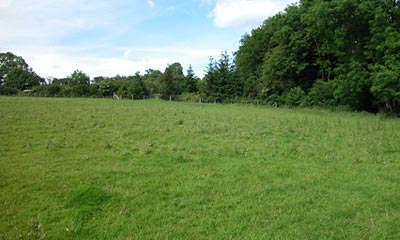270,000 New Homes in rural South-East
Take a good look at this one corner of the rural South-East. It will soon be swept away by a tide of 270,000 new homes under John Prescott's unstoppable master plan
The tiny village of Wingfield, in south Bedfordshire, is one of those places where only one side of the main street is houses. On the other side, across the road from the Plough Inn, the Icknield Way drops down gently, giving you a fine view of the fields falling to the town of Houghton Regis in the distance.

It's a classic Green Belt panorama, spoiled only by a pylon line. It's
land that many of the local people still innocently believe is protected.
But in the 50th anniversary year of the Green Belt, this land, and hundreds
of square miles like it, is about to have its Green Belt status cancelled
and its development controls torn up.
Soon, according to South Bedfordshire council's director of planning,
John Hoad, the view from Wingfield will be filled with miles of new houses
- known to Deputy Prime Minister John Prescott as "sustainable communities",
known to their inmates as "Badger Copse" or perhaps "The
Kingfishers", and known to the rest of us as developers' boxes.
If, as is entirely possible, the bright red terracotta roofs and the executive carports reach all the way up the hill, the Plough Inn will find itself transformed from a thatched country pub into a roadhouse in a suburb of Greater Luton.
"People are unaware of what is going to hit them," says Mr Hoad. "Some people are going to get surprises when they see just how much land will be included and how much things will change.
There's going to be a lot of controversy when the planning applications start coming in."
The land south of Wingfield is Ground Zero for the whole of the southern England Green Belt. It is one of the very first places likely to be redeveloped into attractive Concrete Belt under new fasttrack planning procedures, coming soon to a field near you.
In the run-up to the election, the voters and the tabloids spent much
of their time frothing about gipsy sites. But this far greater threat
to the countryside has arrived almost beneath the radar.
Published last month under the deliberately boring name of the "Milton
Keynes and South Midlands (MKSM) Sub-Regional Strategy", the plan
is to build 170,000 new homes in Bedfordshire, Buckinghamshire and Northamptonshire
over the next 16 years - with a further 100,000 to come in the decade
beyond that.
It has already been agreed and approved. No elected body had any power
over the process. No elected body has any power to stop it. Objections
- and there were strenuous objections - were almost entirely ignored.
It is going to happen. Now it only remains to tell the public.
" But that land is Green Belt," says Gillian Goodyear, whose house
stands in the middle of Wingfield. Not for much longer, I tell her.
In nearby Tebworth, another thatched, half-timbered sort of place, Ian Lothian has heard of the plans. But he didn't think the houses were coming that close.
"This is a conservation village," he says.
The exact location of the developments is still to be decided - and Tebworth is more likely to be spared than Wingfield.
But even here, on the new-build frontline, people still cling to the
props of the old planning system - Green Belts, conservation villages
- unaware that, in the "Milton Keynes-South Midlands subregion",
these now have about as much meaning as government bonds in the Weimar
Republic.
It's hardly fair to blame these villagers for not realising what's happening.
New Labour hasn't made it easy for them.
"This Government, as I have made clear on every occasion, is committed to preserving and extending the Green Belt in all our regions," wrote Mr Prescott little more than a year ago.
Even as the MKSM strategy was launched, the planning minister, Lord
Rooker, described it as a way to "preserve and enhance the local
countryside".
The truth, says Norman Costin, the leader of South Bedfordshire District
Council, is a little different. "We have virtually no brownfield
sites that aren't already committed. Probably 95 per cent of the development
in our area will have to be in the Green Belt.
" That's 39,600 new homes, 100,000 more people, perhaps 60,000 more cars.
Certainly, there'll be hearings and a formal Green Belt review. But the council is allowed to come to only one conclusion. The new housing in South Beds, as in every other part of the " subregion"is non negotiable.
"We've had our rights trampled on,"says Mr Costin - who lives,
ironically, in Wingfield. "One minute Bedfordshire had a structure
plan, worked up over three or four years by the democratically elected
councillors of Bedfordshire. The next minute it was gone. It is frightening."
Worried about low-paid workers being priced out of the property market,
the Government is trying to reduce house prices by increasing the supply.
Under an Act passed last year, Whitehall effectively took control of
the strategic planning system away from local councils, giving itself
the power to impose vast quantities of house-building.
MKSM is one of four mammoth development areas planned for the South-East, the others being the Thames Gateway, Ashford in Kent and, most controversially, the entire length of the M11 from the outskirts of London right up to Cambridge. In Surrey, there is also talk of a "London Fringe sub-region" which will impose up to 40,000 new homes right along the North Downs. But MKSM is the template, the most advanced area, the pointer for what may happen across the region. And that template is a pretty worrying one.
The only supposedly representative bodies with any power at all over
the outcome in MKSM were three of Mr Prescott's mysterious "regional
assemblies", composed of specially nominated councillors from as
far away as Buxton, Derbyshire, and "stakeholders" from places
like the Brighton office of the Arts Council.
Any real stakeholders, notably the public or any organisation actually
elected by them, were reduced to the status of supplicants at a five-week "examination
in public" conducted by "independent inspectors".
The inspectors, in turn, were prevented by Mr Prescott from questioning the principle of growth.
But they did say that "decisions about development were being imposed by a process in which [local people] had not been involved" and spoke of their real fears about the Government's "more haste, less speed" approach.
And for all Mr Prescott's "sustainable communities" flannel, the inspectors noted there was no overall target in the plan for affordable housing.
"The rationale of this development is supposedly to reduce the cost of housing in the South-East," said Julie Stainton, of the Campaign to Protect Rural England. "But what we have seen time and again is that developers are given the land and build unaffordable housing on it."
Stainton also points out the "insane" logic of trying to reduce house prices in London by building lots of houses up to 50 miles to the north of it.
"There are plenty of other ways of providing low-cost housing for key workers," says Costin. "Subsidised mortgages, social housing - we'd do it, but we're not allowed to."
COSTIN and his officers have now accepted defeat, and see their task as trying to make the best of the deeply invidious hand they've been dealt.
They may not have been allowed to shape the strategy, but they've still got to implement it. "I tried to buy the website 'itsnotmyfault.com'," quips Costin.
One vital question will be whether the transport comes in with the houses - or whether the area, already at a standstill for most of the morning rush-hour, is left to seize up completely.
Dunstable is the largest town in south-eastern England without a railway station, and Thameslink, the company serving nearby Luton, runs the most overcrowded trains in Britain. So far, no rail improvements whatever are promised.
Back in Wingfield and Tebworth, the reality is starting to sink in. "I'm appalled at the lack of consultation," says Debbie Parry of Tebworth. "I think there'll be a big backlash."
She is almost certainly right. The future of the Green Belt will be a gigantic issue in the next parliament - yet, like so many of those issues, it barely features in the current campaign to elect that parliament.
A few of the candidates have it on their literature. Michael Howard has made a speech on the subject and there is real difference between the parties. The Tories are pledged to protect the Green Belt and steer mass housebuilding to brownfield sites.
Yet somehow, even in an area with five Labour marginals, it is an issue that has not yet caught fire.
Just as nobody talked about the poll tax during the 1987 election, we may this time be passing up our last and only chance to express some sort of democratic verdict on the Green Belt.
Evening Standard
